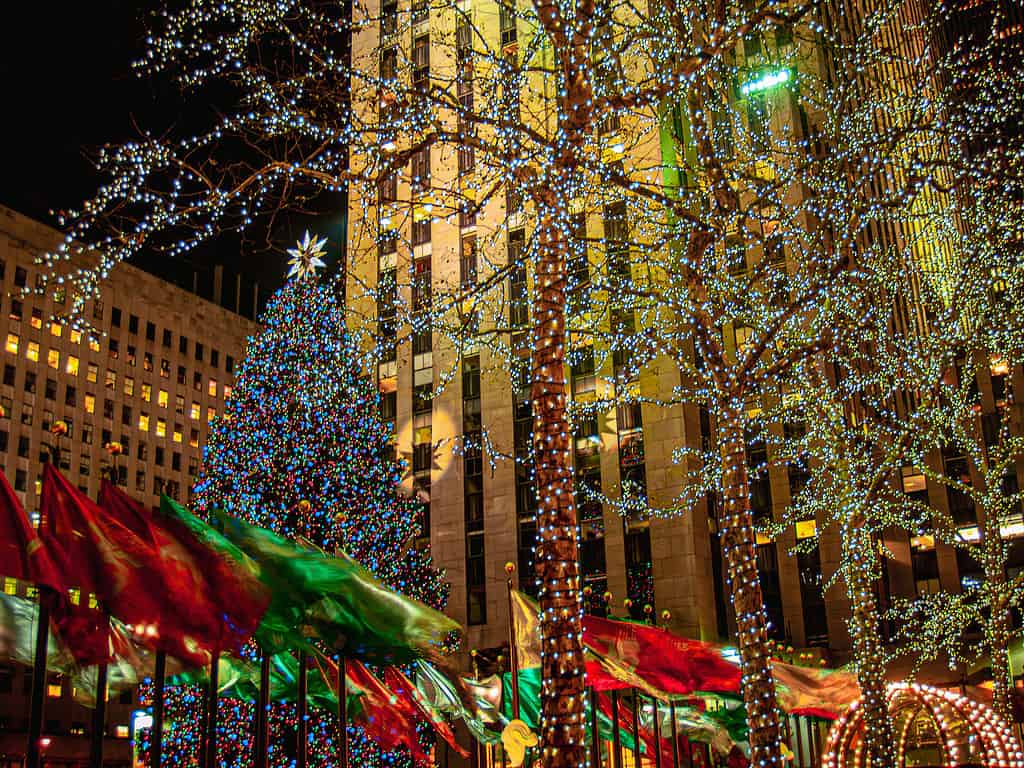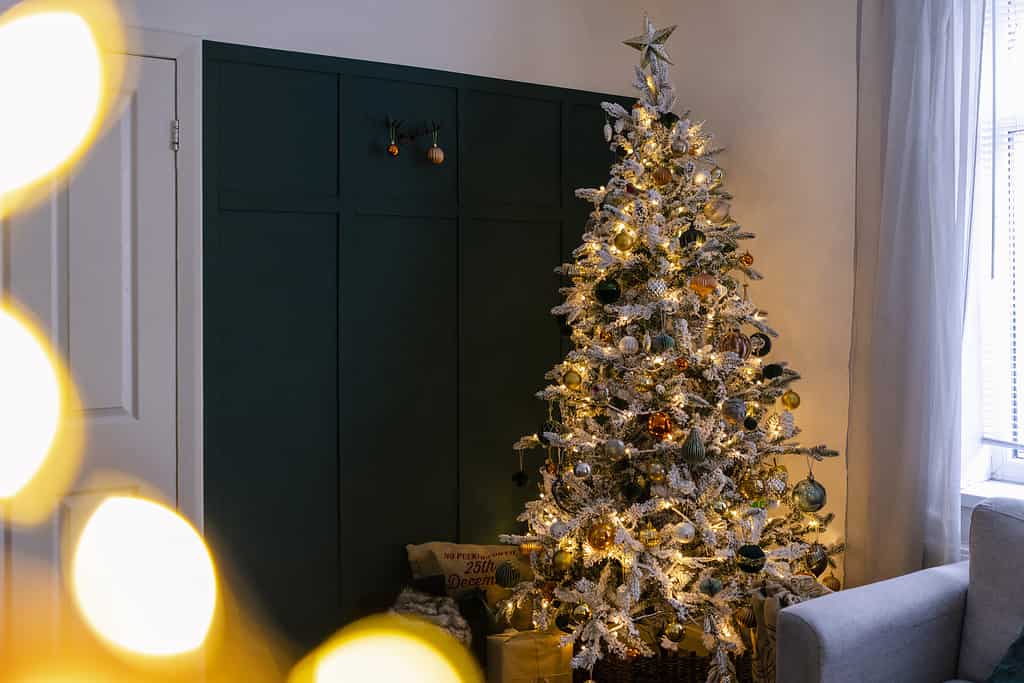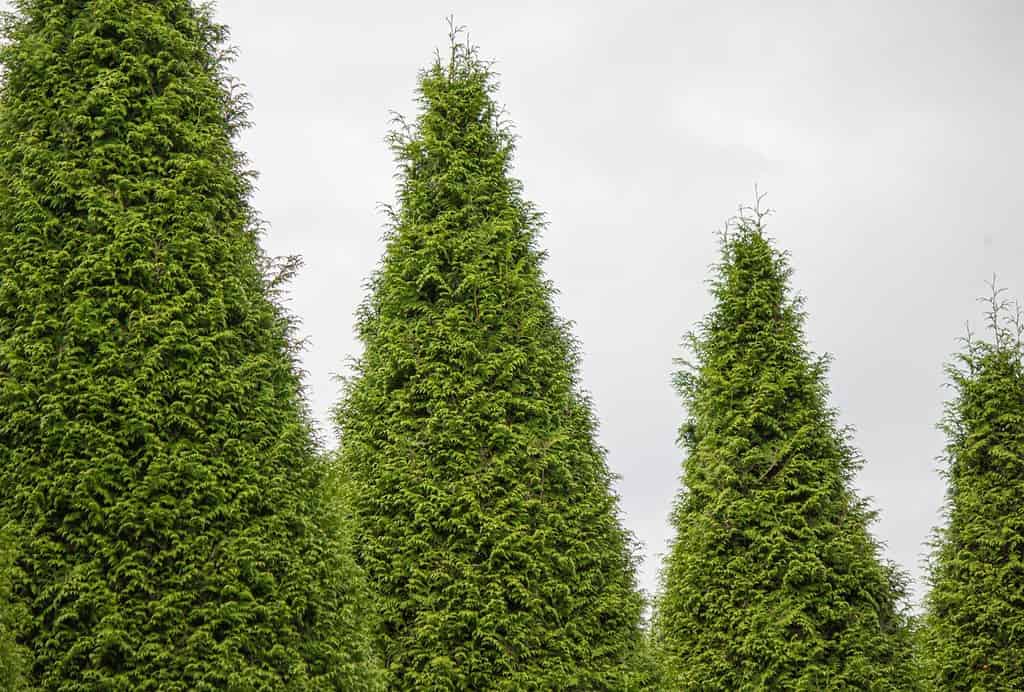Did you know the type of Christmas tree you have in your home can vary greatly by your location? There are roughly 16 species of Christmas trees in the United States. Today we’re going to be looking at a handful of the most common species and how much you can expect to spend on a Christmas tree this year.
Whether you’re looking for an idyllic real tree from a local farm or an artificial tree from a big box store, we have the answers you’re looking for!
Factors of Buying a Real Christmas Tree vs. Artificial

Christmas trees originated in Germany!
©andykazie/ via Getty Images
Here are some things to keep in mind before getting your next Christmas tree.
Transporting
One of the first things you’ll want to think about is how you’re going to get a tree from point A to point B. Some tree farms pack trees in netting that drastically reduces their size. When you’re buying an artificial tree, most big box stores and online shops will send the tree in a large box right to your doorstep.
If you’re getting a real tree from a local farm, consider your drive home. You may need to bring ropes or bungee cords to secure the tree atop your vehicle. Be aware of any clearance on narrow roads, tunnels, and other locations.
Consider Allergies
If you or anyone who will be in your home during the holidays has severe allergies, this is something to keep in mind. Tree sap and pollen are the biggest culprits when bringing a tree into your home.
You can always be strategic with where you place the tree within your house if someone does have allergies. If someone does have allergies, consider placing the Christmas tree on another floor or at the opposite end of where they spend the most time.
Budget

84% of people opt for an artificial Christmas tree.
©DGLimages/ via Getty Images
Of course, budget plays a massive role during the holidays. This guide will dive into the different prices for a variety of popular Christmas trees in the United States. The amount you allot for a real tree is one of the major deciding factors of which type and size you’ll be going home with.
Artificial Christmas trees are typically much more affordable. They can be reused year after year and create much less of a mess. Although they don’t have that enticing fresh-cut-tree smell or the appearance of a real tree, the majority of people opt for an artificial Christmas tree.
Dimensions
Picking up a nine-foot-tall tree when you have eight-foot ceilings is just going to leave you stressed. While some people get creative with trees that are too large for their space, taking measurements before will save you the headache.
You should measure the height and the circumference of where you’re planning to set up your tree. Bring a tape measure with you when you shop for a real Christmas tree. This will ensure you find the perfect size for your space!
Thankfully, when you buy an artificial Christmas tree, the dimensions are easily accessible.
Upkeep
One of the main differences between a real and artificial tree is the upkeep. For starters, a fake tree requires a tedious setup and take-down process. You’ll have to fluff the branches each year to fill in the empty spaces that real Christmas trees lack.
Once you have your faux tree all set up, the upkeep is essentially non-existence. It’s important to mention that they also take up room in terms of storage. For real trees, you’ll have to keep any pets away, as the needles can be incredibly sharp and toxic.
Real trees also require daily watering, as well as routine clean-up of fallen needles. Once the holiday is over, you’re responsible for properly disposing of the tree.
Common Christmas Tree Species to Choose From
1. Douglas Fir

You should water a Douglas fir about once per week.
©arlutz73/iStock via Getty Images
One of the most common Christmas trees found all over the Midwest and Northern portions of the United States is the Douglas fir. Despite its name, the Douglas fir is not a true fir and technically is its own species classification.
The cone of the Douglas hangs down and typically only has an aroma when smashed. One reason this is a popular Christmas tree is because the needs are soft. They won’t harm pets or young children, yet they can still hold plenty of lights and ornaments.
2. Norway Spruce

Norway spruce trees are among the oldest trees in the world.
©KawaiiS/Shutterstock.com
If you love the smell of a freshly cut Christmas tree, look no further than the Norway spruce. It has a distinct aroma that will instantly fill your home with the holiday spirit. One of the most important things to know about this species is just how quickly it drops its needles.
This is a great option for a last-minute shopper, as Norway spruce starts losing needles as soon as you bring it home. This makes it easier when it comes time to dispose of the tree. Like other real trees, you’ll want to regularly water it.
Whether you get a faux or real Norway spruce, the bright, green hues are perfect for the holiday season. There is a conical shape that easily fits stars and angel tree toppers. The needles are relatively spiky, giving even artificial trees a realistic appearance.
3. White Pine

White pines are known for their massive pine cones.
©Sunshine Haven Photo/Shutterstock.com
Whether you’re looking for a tree with a light aroma or you live with someone with allergies, the white pine is an idyllic Christmas tree. The white pine is famous for its full shape, providing a dense and thick appearance.
The needles are feathery and sock, leaving all worries of being painfully pricked a thing of the past. The white pine has a moderate scent that doesn’t overwhelm a room or trigger allergies. Because of the needle density, it holds ornaments and lights with ease.
4. Eastern Red Cedar

Red cedar trees are drought-resistant.
©Wirestock Creators/Shutterstock.com
Despite its name, an eastern red cedar is actually a juniper tree! This is a stunning Christmas tree that is common in the southern portion of the country. Many homeowners love the pyramid crown instead of the cone shape you can find on other species.
The eastern red cedar does require more upkeep and needs to be pruned regularly. The dark, glossy needles add the perfect holiday touch to your home. If you don’t have kids or pets, you’ll enjoy the beautiful appearance of the sharp, and prickly needles.
5. Balsam Fir

This type of tree is famous for its ability to withstand extremely cold temperatures.
©Sonia Horowitz/Shutterstock.com
A balsam fir is a classic Christmas tree that has beautiful deep green needles. Not only does it look beautiful in your home, but the needle retention requires less clean-up than other species. It’s incredibly fragrant, giving your home an earthy aroma through the holiday season.
It has a thin top that holds a tree topper perfectly. The needs are flat and blunt in comparison to other trees, making it ideal for homes with children or pets. Lastly, balsam firs have strong branches that can hold large ornaments and lights.
6. Fraser Fir

A Fraser fir will keep its needles for about 40 days after being cut.
©Iris_Images/Shutterstock.com
If you’re along the east coast, the Fraser fir is one of the most popular Christmas trees. It’s similar to a balsam fir with the exception of the needle color. Fraser firs have a stunning silvery-blue underside.
Like their balsam cousin, Fraser firs have great needle retention and the needles have a glossy dark green shade on top with a shimmery silver coloring underneath. The branches turn upwards, making the tree look more full.
This tree has a woodsy aroma that is a bit more subtle than a balsam. The thick branches hold most types of ornaments. Lastly, Fraser fir trees can easily hide cords due to their dense appearance.
Summary of Christmas Tree Prices in 2023
| Rank | Tree Species | Real 7.5 Feet | Artificial Unlit 7.5 Feet |
|---|---|---|---|
| 1 | Douglas Fir | $75 | $200 |
| 2 | Norway Spruce | $60 | $200 |
| 3 | White Pine | $100 | $60 |
| 4 | Eastern Red Cedar | $150 | $400 |
| 5 | Balsam Fir | $300 | $150 |
| 6 | Fraser Fir | $200 | $120 |
The photo featured at the top of this post is © Enio DePaz/ via Getty Images
Thank you for reading! Have some feedback for us? Contact the AZ Animals editorial team.







